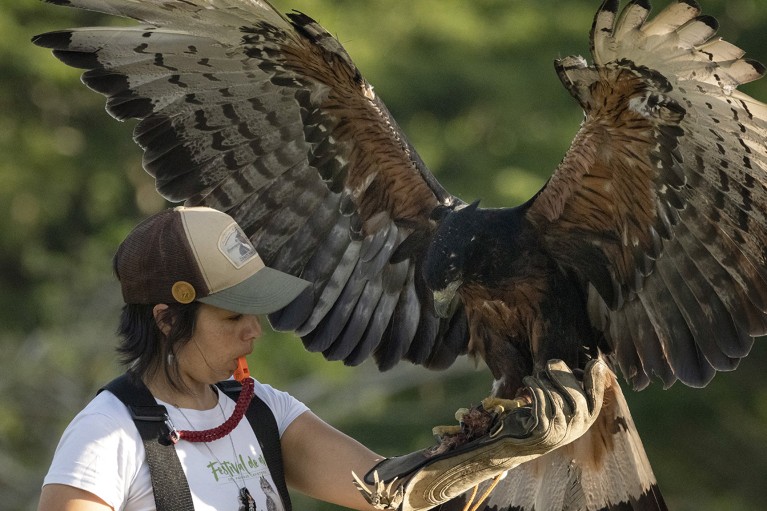Hello Nature readers, would you like to get this Briefing in your inbox free every day? Sign up here.

Ana María Morales trains Morgan, an unreleasable black-and-chestnut eagle (Spizaetus isidori) at the Eagles of the Andes Foundation in Pereira.Credit: Gilder González
Colombia considers animal-research ban
Lawmakers in Colombia are considering whether to ban almost all science and education using live animals. One piece of legislation was rescinded after backlash from scientists, but two others remain active:
• A draft constitutional amendment that would recognize animals as people, with commensurate legal protections.
• A pending Senate bill that would curtail animal research and overhaul the country’s ethical-approval process. The bill’s wording is vague, but it states that “the use of live animals in academic and scientific research, toxicity-testing studies, biological or related studies” is prohibited when the results can be obtained “by other means” or when using “live animals of a higher grade on the zoological scale”.
Redlining hobbles US bird data
A racist 1930s policy called ‘redlining’, which was used to define some urban neighbourhoods in the United States as high risk for real-estate investors, has had myriad lasting impacts. One of them is a dearth of ecological data from some places whose residents are mainly people of colour. Ecologist Diego Ellis-Soto has been teaching Black and Hispanic children in New Haven, Connecticut, how to birdwatch. “I could go there one day and double what’s been collected in the last 100 years,” says Ellis-Soto about one historically redlined neighbourhood. He has led research showing that “redlined neighbourhoods remain the most undersampled urban areas for bird biodiversity today, potentially impacting conservation priorities and propagating urban environmental inequities”.
Reference: Nature Human Behaviour paper
Features & opinion
Is it time to reboot cosmology?
Observations by the James Webb Space Telescope (JWST) suggest that “we may need to rethink key features of the origin and development of the Universe”, argue astrophysicist Adam Frank and theoretical physicist Marcelo Gleiser. JWST has revealed galaxies that formed much earlier than was thought possible. And it has confirmed measurements, made by the Hubble Space Telescope, that point to a flaw in the models that predict how fast the Universe is expanding. “Physicists and astronomers are starting to get the sense that something may be really wrong,” write Frank and Gleiser.
The New York Times | 8 min read
Futures: Head talk
A wiley character does what it takes to get ahead in the latest short story for Nature’s Futures series.
Podcast: human ancestors nearly died out
Our distant ancestors nearly went extinct around 900,000 years ago, according to genetic analysis. The unknown human-like species was reduced to just 1,280 breeding individuals, creating a genetic bottleneck that is still detectable in the DNA of modern-day humans.
Nature Podcast | 13 min listen
Subscribe to the Nature Podcast on Apple Podcasts, Google Podcasts or Spotify, or use the RSS feed.
